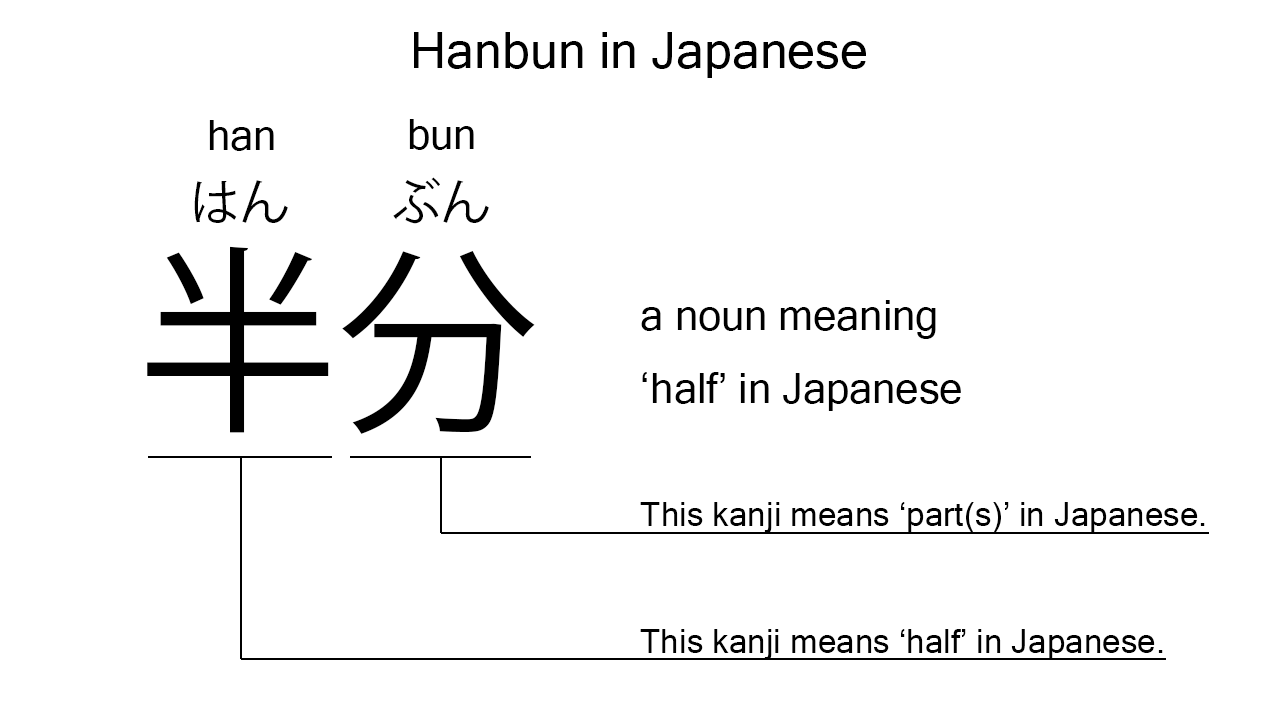What does “hanbun” mean in Japanese?
Native speakers use hanbun to mean a ‘half’ in Japanese. Perhaps, some Japanese learners know this word as it is sometimes used in Japanese conversations. In this blog post, however, I will explain this word in detail based on its kanji expression. And also, I will explain how to use it through example sentences. My explanations would help Japanese learners understand hanbun more clearly. Then, let’s get started!
Contents
Definition and meaning of “hanbun”
Let me start with the definition and meaning of hanbun.
- hanbun – 半分 (はんぶん) : a noun meaning a ‘half’ in Japanese. This can also work as plural. Learn more about Japanese plural.
Native speakers use this noun to refer to a half part of something in Japanese. In addition, they use this like a pronoun depending on the context and situation. So, its usages are very similar to those of the English word, half, I think.
The definition and meaning are simple and clear. To understand this noun more clearly, however, let me explain its kanji characters in detail, one by one.
Hanbun in kanji
The kanji expression of hanbun consists of the following two kanji characters:
- 半 : a kanji character widely used to mean a ‘half’ in Japanese.
- 分 : a kanji character widely used to mean a ‘part’ in Japanese. This can also be found in other words like jibun and tabun.
From these two kanji characters, we can understand that hanbun literally means a ‘half part’ in Japanese. This literal interpretation is completely in line with the actual meaning.

When we meet new kanji expressions, we should check their kanji characters in detail to understand their meanings clearly and deeply. In many cases, kanji characters tell us a lot about the meanings of the expressions they form. Actually, here, we could get the better understanding of hanbun through the detailed kanji check above.
So far, I’ve explained the definition and meaning of hanbun together with its kanji characters. Then, let me explain how to use it through the example sentences below.
How to say “half” in Japanese
kanojo wa kono momo no hanbun wo tabe ta – 彼女はこの桃の半分を食べた (かのじょはこのもものはんぶんをたべた)
She ate half of this peach.
Below are the new words used in the example sentence.
- kanojo – 彼女 (かのじょ) : a pronoun meaning ‘she’ in Japanese.
- wa – は : a binding particle working as a case marker or topic marker. In the example, this works after kanojo to make the subject in the sentence.
- kono – この : a determiner used before a noun which refers to something close to the speaker. In the example, this is used before momo to mean ‘this peach’ in Japanese.
- momo – 桃 (もも) : a noun meaning a ‘peach’ in Japanese. This can also work as plural.
- no – の : a case particle joining two nouns. Normally, the first one can work as a modifier to describe the second. In the example, this works to join kono momo and hanbun. The formed phrase literally means ‘half of this peach’ in Japanese. Word orders in Japanese and English are different, but the role of this case particle is similar to that of the English preposition, of.
- wo – を : a case particle used to make the object word in a sentence. In the example, this is used after kono momo no hanbun to make the object in the sentence.
- tabe – 食べ (たべ) : one conjugation of the verb, taberu, which means ‘to eat’ in Japanese. In the example, it has been conjugated for the better connection with its following word.
- ta – た : an auxiliary verb used after a verb, adjective, or auxiliary verb to make its past tense form. In the example, this is used after tabe to make its past tense form, tabe ta.
This is a typical usage of hanbun. In this example, it works as a part of the noun phrase, kono momo no hanbun, which means ‘half of this peach’ in Japanese.
Another example of “hanbun”
seito no hanbun ga gakkou ni ki ta – 生徒の半分が学校に来た (せいとのはんぶんががっこうにきた)
Half of the students came to the school.
Below are the new words used in the example sentence.
- seito – 生徒 (せいと) : a noun meaning a ‘student’ in Japanese. This can also work as plural.
- ga – が : a case particle used to make the subject word or the object word in a sentence. In the example, this is used after seito no hanbun to make the subject in the sentence.
- gakkou – 学校 (がっこう) : a noun meaning a ‘school’ in Japanese. This can also work as plural.
- ni – に : a case particle used to say where someone or something goes. In the example, this is used after gakkou to say where half of the students came.
- ki – 来 (き) : one conjugation of the verb, kuru, which means ‘to come’ in Japanese. In the example, it has been conjugated for the better connection with its following word.
This is another example of hanbun. In this example, it works as a part of the noun phrase, seito no hanbun, to mean ‘half of the students’ in Japanese. When we want to refer to a half part of something in Japanese, hanbun is always a very good option.
Summary
In this blog post, I’ve explained the definition and meaning of hanbun in detail based on its kanji expression. And also, I’ve explained how to use it through the example sentences. Let me summarize them as follows.
- hanbun – 半分 (はんぶん) : a noun meaning a ‘half’ in Japanese. This can also work as plural. These two kanji characters literally mean a ‘half part’ in Japanese. This literal interpretation is completely in line with the actual meaning.
Hope my explanations are understandable and helpful for Japanese learners.
Leave a Reply